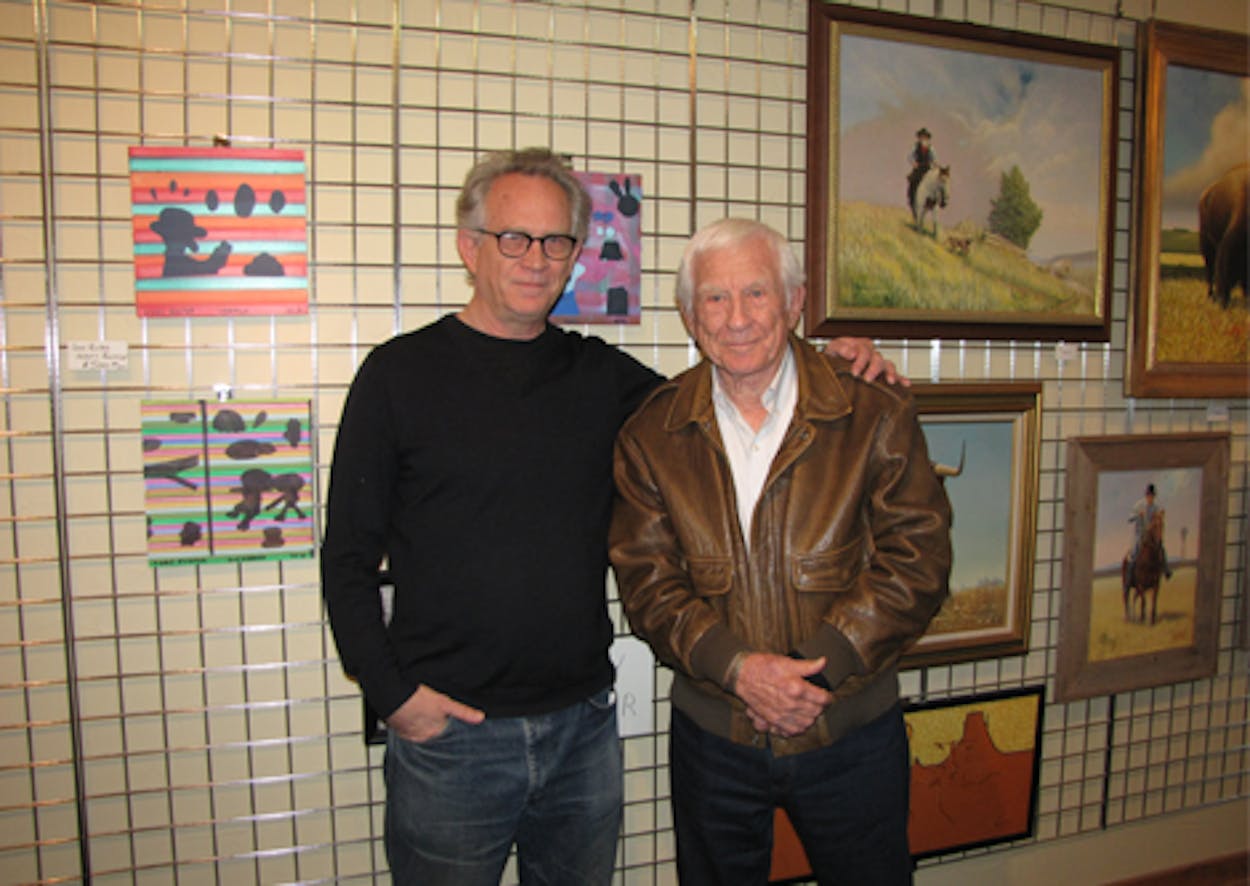It was a perfect family moment for Gary Panter—the punk visionary, underground comics master and Pee-wee’s Playhouse set designer—and his father, Mel. The son’s culture-bending, Day-Glo artwork was displayed in a small-town gallery in Northeast Texas alongside his father’s oils of iconic Texana.
Gary, 61, flew in from New York for the holidays with eleven of his paintings for his first art exhibition in his sleepy hometown of 15,400, about eighty miles northeast of Dallas. Son and father toted their work to the downtown Connally Street Gallery, and their show’s December 26 opening night had the jarring yet oddly sweet feel of performance art.
Gary’s masonite boards featured semi-naked women, a head-chopping cyclops named Andy, and a doe-eyed goldfish. On his father’s canvases, cowboys galloped after stray dogies or dozed in bluebonnets, Indians rode in canyon shadow, and longhorn and buffalo stood as proud as stock-show champions.
“Seeing my work next to his, it’s a wonderful thing,” Gary said, smiling at his 84-year-old father and munching on Walmart-brand pimento cheese on white bread. “He’s a serious artist.”
As is Gary. He is best known for creating the outlandish world of Pee-wee’s Playhouse, which won him three Emmys and forever altered Saturday morning television. Before that, he defined punk art and culture, creating album covers for musicians as varied as the Red Hot Chili Peppers and Doc and Merle Watson. His work so influenced his friend and fellow artist Matt Groening, creator of the Simpsons, that Bart’s spiky hairline is an homage to Gary’s cartoon character, Jimbo. In the fall, an art-comic magazine declared Gary the Jackson Pollock of comics.
The idea for the father-son show came in August, when Gary visited for a high school reunion. Pam Elliott, whose husband was a few years behind him, mentioned opening an art gallery downtown. She jokingly asked if Gary might show his work. He proposed a Christmas show.
Mel offered his art, and Gary promised to bring as many paintings as he could fit in his carry-on luggage when he and his wife and daughter flew down for the holidays.
On the night after Christmas, the cartoonist and his white-haired father warmly greeted childhood pals, coffee-drinking buddies, and church friends who flocked to the cozy art space.
Gary, low-key in Wranglers, a black T-shirt and a sweater, reminisced about playing trumpet in high school band with Phil Sartin, a local resident. He hugged a classmate, Sue Payne, who watched him draw his way through elementary school and recalled him “always doing dinosaurs.” He smiled when his high school art teacher, Lillian Thompson, recounted his struggles with a geometric art project. And when someone asked for an autograph on a Jimbo comic book, Gary sat down and drew a cartoon.
Gary’s mother, Merle, beamed. Asked about her son, she pulled out a set of handwritten notes.
“Gary has always been a winner,” she said, breezing through his groundbreaking career with a mother’s-eye view: from the monster-drawing contest that he won as a child and the spot he earned in a Yale summer art program in college to the honor of having a restaurant in Japan name a hamburger after him as his career took off. She talked about his Emmys (one of which sits in her home) and the Chrysler Design Award he received in 2000 for his influence on American art and culture—two years before Steve Jobs was deemed worthy of the same honor.
Gary credits his father, who managed dime stores in Oklahoma before moving his family to Sulphur Springs in the 1950s. Mel painted cartoons over his oldest son’s crib and encouraged him to draw as soon as he could hold a pencil. “By the time I was eleven, I knew I wanted to be a modern artist,” Gary said.
Modern with a decidedly freaky edge. Monsters became a mainstay after Gary saw the movie fanzine Famous Monsters of Filmland. Copies of Mad magazine from a downtown drug store were also transformative influences, along with the Frank Zappa albums he found at a local music store.
All that still puzzles Gary’s parents, who prefer the six-days-of-creation diorama he painted as a teen for their Church of Christ. “We’ve always been amazed at Gary, and we’ve always gone along with him,” Merle said. “Some of his stuff, I’m not too proud of, but say we’ve always been supportive.”
Gary knows his acid-trip oeuvre is beyond weird for his parents and his hometown. He was not surprised that none of his art had sold there by the new year, though he priced it at half the usual $1,000 per painting.
Yet the place, its landscape and even his parents’ fundamentalism infuse his work, even if in rebellion.
Last fall, Gary created an illustrated essay for a new McSweeney’s food magazine, Lucky Peach, to celebrate the peanut patties, Tex-Mex, barbecue and other Texas staples that he savors in his hometown. His newest comic collection, to be published next spring, includes an introduction that he says amounts to “the history of Sulphur Springs in geologic terms.”
“Gary has never painted a bluebonnet,” Mel said, “and the closest I come to monsters is a buffalo.”







